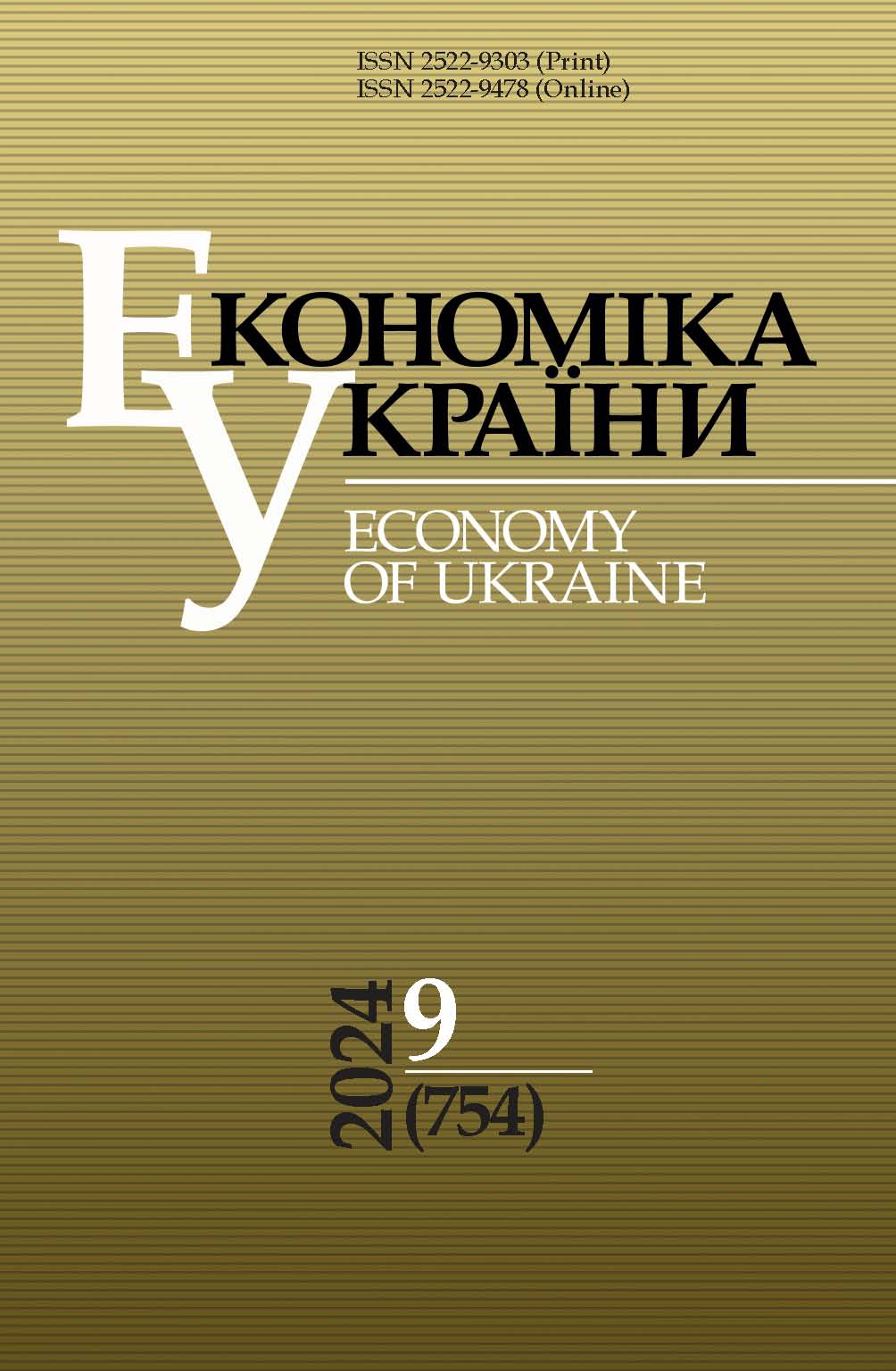СОЦІАЛЬНО-ЕКОНОМІЧНЕ ПІДҐРУНТЯ СОЦІАЛЬНОЇ ВРАЗЛИВОСТІ ПРАЦЕЗДАТНОГО НАСЕЛЕННЯ
DOI:
https://doi.org/10.15407/economyukr.2024.09.064Ключові слова:
соціальна вразливість; соціальні ризики; робоча сила; людський капітал; бідність працездатного населення; соціальне страхуванняАнотація
Україна – соціальна держава, у якій питання захисту соціальних прав є першочерговими і становлять основу сталого розвитку країни. Попри масштабність соціальних реформ, у країні не зменшилася соціальна нерівність, а якість програм соціального захисту не відповідає потребам. З огляду на таку проблематику, досліджено динаміку соціальної вразливості працездатного населення задля осучаснення її змістовності, що є основою забезпечення реалізації захисту соціальних прав за принципом соціальної справедливості з урахуванням інклюзії. Використано методи обробки даних, аналізу, системного підходу, узагальнення. Методологія дослідження ґрунтується на залученні даних електронних джерел і відкритої статистики.
Дослідження динаміки факторів соціальної вразливості працездатного населення свідчить про незмінність соціальних ризиків та їх посилення. Їх нашарування – це каталіз, що спричиняє і спричинятиме зростання соціальної нерівності. Аналіз дає можливість виокремити такі індикатори низької ефективності дій, що є підґрунтям соціальної вразливості: за достатнього рівня продуктивності праці – низький рівень заробітної плати, за високого рівня охоплення освітою населення – невисокий рівень якості робочої сили, за великою кількістю навчальних закладів – незмінна проблема першого працевлаштування серед випускників, невідповідність між попитом і пропозицією на ринку праці.
Посилення вразливості до наслідків нових ризиків (передчасне вилучення з ринку праці, зниження працездатності й мобільності, знецінення людського капіталу, втрата покоління працездатного віку) є неминучим, тому головне завдання – недопущення загострення синдрому відкладеного життя на невизначений проміжок часу. Нині особливо гостро постає потреба в оцінюванні чутливості соціальної вразливості, оскільки ніхто не може бути захищеним від наслідків непередбачуваних ризиків. Відповідно, пріоритетом у соціальному захисті має бути не соціальне утримання, а надання можливостей ефективно використовувати й накопичувати людський капітал.
Посилання
Ackerman, G. (2006). It is hard to predict the future: The evolving nature of threats and vulnerabilities. OIE Revue Scientifique et Technique, 25(1), 353-360. https://doi.org/10.20506/rst.25.1.1673
Fekete, A. (2009). Validation of a social vulnerability index in context to river‐floods in Germany. Natural Hazards and Earth System Science, 9(2), 393-403 URL: https://nhess.copernicus.org/articles/9/393/2009/nhess-9-393-2009.pdf
O’Keefe, P., Westgate, K., Wisner, B. (1976). Taking the naturalness out of natural disasters. Nature. No. 260. Р. 566-567. https://doi.org/10.1038/260566a0
Downing, T., Patwardhan, A., Klein, R., Mukhala, E., Stephen, L., Winograd, M., Ziervogel, G. (2005). Assessing vulnerability for climate adaptation. URL: https://www.academia.edu/25186738/Assessing_vulnerability_for_climate_adaptation
Thomas, D., Jang, S., Scandlyn, J. (2020). The CHASMS conceptual model of cascading disasters and social vulnerability: The COVID‐19 case example. International Journal of Disaster Risk Reduction. Vol. 51. 101828. https://doi.org/10.1016/j.ijdrr.2020.101828
Turner, B., Kasperson, R., Matson, P., McCarthy, J., Corell, R., Christensen, L., Eckley, N. et al. (2003). A framework for vulnerability analysis in sustainability science. Proc. Natl. Acad. Sci., 100 (14), 8074-8079. https://doi.org/10.1073/pnas.1231335100
Georg, F., Jeroen, W., Bart, W. (2011). The politics of vulnerability and resilience. Ambiente Sociedade, 14(2), 105-122. https://doi.org/10.1590/S1414-753X2011000200008
Sneha, B., Sunil, N. (2023). A review of socio-economic vulnerability: The emergence of its theoretical concepts, models and methodologies. Natural Hazards Research. Vol. 3. Iss. 3. P. 563-571. https://doi.org/10.1016/j.nhres.2023.05.005
Calderón‐Larrañaga, A., Dekhtyar, S., Vetrano, D., Bellander, T., Fratiglioni, L. (2020). COVID‐19: Risk accumulation among biologically and socially vulnerable older populations. Ageing Research Reviews. Vol. 63. 101149. https://doi.org/10.1016/j.arr.2020.101149
Fallah‐Aliabadi, S., Fatemi, F., Heydari, A., Khajehaminian, M., Lotfi, M., Mirzaei, M., Sarsangi, A. (2022). Social vulnerability indicators in pandemics focusing on COVID‐19: A systematic literature review. Public Health Nursing. Vol. 9. Iss. 5. P. 1-14. https://doi.org/10.1111/phn.13075
Libanova, Е., Pozniak, O., Tsymbal, O. (2022). Scale and consequences of forced migration of the population of Ukraine as a result of armed aggression of the Russian Federation. Demography and Social Economy. No. 2(48). P. 37-57. https://doi.org/10.15407/dse2022.02.037 [in Ukrainian].
Bil M. (2022). Forced migration under conditions of high social vulnerability of the population of Ukraine. Migration & Law. Vol. 2. No. 5-6. P. 31-43. http://doi.org/10.32752/2786-5185-2022-2-5-6-31-43 [in Ukrainian].
Andrusyshyn, N. (2022). Social vulnerability of the population: definitions, approaches to understanding and evaluation. Economy and Society. Vol. 37. https://doi.org/10.32782/2524-0072/2022-37-42 [in Ukrainian].
Ryndzak, O. (2021). Social vulnerability of the population and its conceptual and terminological provision. Economy and Society. Vol. 33. https://doi.org/10.32782/2524-0072/2021-33-79 [in Ukrainian].
Bidak, V. (2023). Social vulnerability of the population of Ukraine in the focus of strengthening national security. Regional Economy. No. 3 (109). P. 70-85. https://doi.org/10.36818/1562-0905-2023-3-6 [in Ukrainian].
##submission.downloads##
Опубліковано
Як цитувати
Номер
Розділ
Ліцензія
Авторське право (c) 2024 Видавничий дім "Академперіодика" НАН України

Ця робота ліцензується відповідно до Creative Commons Attribution-NonCommercial-NoDerivatives 4.0 International License.



